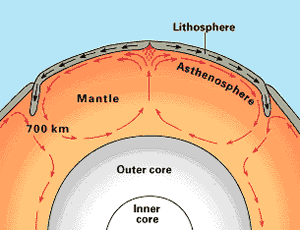BACKGROUND:
Children are fascinated with the spectacular volcanic
eruptions that occur throughout the world. Volcanoes are very important for
interpreting what is occurring within the outer portion of the Earth. In
addition, as the new Earth developed 4.5 billions years ago, volcanoes
released steam, which later became one of the major sources of water on this
planet. Volcanoes produce volcanic rocks (igneous rocks) that have built the
surface of the Earth. In the theory of Plate Tectonics, most volcanoes are
produced where two lithospheric plates (the outer skin of the earth) either
diverge (move away from each other) or converge (come together, usually with
subduction).
Volcanoes have many different shapes, and can be
composed of different types of volcanic rock. Throughout the Plate Tectonic
Cycle we will use a simplified volcano shape classification based on the
types of materials that compose volcano. Other resources may describe other
types of classifications. We distinguish three shapes of volcanoes. First, a
shield volcano is composed of lava. The name shield describes the low, broad
structure of the volcano, like an inverted shield. The Hawaiian volcanoes
are shield volcanoes. Second, a cinder cone is a steeper structure and is
composed of cinders (or finely pulverized rock) that were explosively
erupted from the volcano. Third, a composite volcano is composed of mixed
layers of ash and lava. Composite volcanoes are frequently much higher than
shield volcanoes,  but not as steep as cinder cones. Mt. Shasta in
California, and Mt. Fuji in Japan are examples of composite volcanoes.
but not as steep as cinder cones. Mt. Shasta in
California, and Mt. Fuji in Japan are examples of composite volcanoes.
PROCEDURE:
-
Introduce your
students to the Plate Tectonic Cycle, by telling them that the outer
part of the Earth, its skin, is composed of lithospheric plates of rock.
Explain that these plates move, and it is this movement that causes
earthquakes and volcanoes. Tell them that this unit will show students
the different kinds of volcanoes. You may want to use selected
pictures from Volcano (slideshow).
-
Draw the diagrams below on the board. Explain the differences among
the three types of volcanoes. Instruct the students decide which type of
volcano is shown on their worksheets. The volcano model, produced by the
U.S. Geological Survey, is a composite volcano.